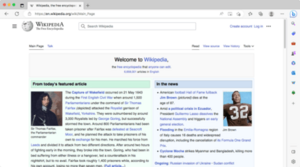Microsoft Edge facts for kids
 |
|||||||

Screenshot of Microsoft Edge, showing the Main Page of the English Wikipedia
|
|||||||
| Original author(s) | Microsoft | ||||||
|---|---|---|---|---|---|---|---|
| Developer(s) | Microsoft | ||||||
| Initial release | January 15, 2020 | ||||||
| Stable release(s) [±] | |||||||
|
|||||||
| Preview release(s) [±] | |||||||
|
|||||||
| Written in | C++, JavaScript, TypeScript, HTML, CSS, Rust, Java (Android only), Swift (iOS/iPadOS/visionOS only) |
||||||
| Operating system |
|
||||||
| Platform | IA-32, x86-64, ARM32, ARM64 | ||||||
| Included with |
|
||||||
| Predecessor | Microsoft Edge Legacy (2015) | ||||||
| License | Proprietary software, based on an open source project | ||||||
Microsoft Edge is a popular web browser made by Microsoft. You can use it on many different devices, like computers, phones, and even Xbox game consoles. It's built using the same technology as Google Chrome, which is called the Chromium project. This version of Edge replaced an older one called Edge Legacy.
On computers with Windows 11, Microsoft Edge is the main browser that comes with the system. Microsoft first released the new Edge in January 2020. Before that, it was available for Android and iOS phones starting in 2017.
By early 2023, Edge became the third most popular web browser in the world, right behind Safari and Google Chrome. Now, it is the second most popular browser for desktop computers, with Safari in third place.
Contents
Cool Features of Microsoft Edge
Microsoft Edge is the default browser on Windows 11, which means it's the one that's already there when you start up the computer. It replaced the older Edge Legacy.
Edge has some neat tools to make browsing easier and more fun.
Special Tools and Design
- Internet Explorer Mode: For very old websites that don't work with modern browsers, Edge has a special "Internet Explorer mode." This mode helps make sure those older sites still load correctly.
- Vertical Tabs: Instead of having your tabs lined up at the top, you can move them to the side of the screen. This can help you see more of your tabs at once.
- Add-ons: You can add extra features to Edge with "add-ons," which are like mini-apps for your browser. There are over 9,000 add-ons available to customize your experience.
- Copilot: Microsoft added a smart assistant called Microsoft Copilot (which used to be Bing Chat). It's a button you can click to ask questions, get help with writing, and more.
- Split Screen: This feature lets you view two tabs at the same time in the same window, side-by-side. It's great for comparing things or multitasking.
- Workspaces: You can create different "Workspaces" to keep your tabs organized for different projects, like schoolwork or hobbies. You can even invite friends to a workspace to look at the same websites together.
Edge for Business
Microsoft also made a special version called Microsoft Edge for Business. This version helps people keep their work and personal browsing separate. It puts them in different browser windows so you don't mix up your school tabs with your fun tabs.
Surf (video game)
If your internet goes out, you can still have fun with Edge! In May 2020, Microsoft added a built-in game called Surf. In the game, you control a surfer who has to dodge obstacles and collect power-ups.
You can play Surf even when you're online by typing edge://surf into the address bar. The game has different modes and characters, and you can play with a keyboard, mouse, or even a game controller. It's similar to the Dinosaur Game in Google Chrome. In 2021, the game got a winter-themed update where you ski down a mountain instead of surfing.
How Edge Was Made
The story of the new Microsoft Edge began in 2017. At that time, Microsoft's CEO, Satya Nadella, wanted the team to make a much better browser. This led to the decision to rebuild Edge from the ground up.
Instead of using their own technology, Microsoft decided to use Chromium, the same open-source project that powers Google Chrome. This big change was codenamed "Anaheim." Using Chromium meant that Edge would work better with more websites and could be brought to more devices.
This change also allowed Microsoft to release Edge for macOS, which was a big deal. A Microsoft browser hadn't been available on Mac computers for 13 years!
Release Channels
To test new features, Microsoft created four different versions, or "channels," of Edge:
- Canary: Gets updated every day with the newest, most experimental features.
- Dev: Gets updated weekly and is a bit more stable than Canary.
- Beta: Gets major updates every 4 weeks and is much more stable.
- Stable: This is the official version that most people use. It's the most reliable.
The first test versions for Windows were released in April 2019. The final, stable version of the new Edge was released to everyone on January 15, 2020. It was later released for Linux and Xbox consoles in 2021.
External links
- Official website for preview builds of Chromium-based Microsoft Edge: https://www.microsoftedgeinsider.com
- Translate; Microsoft Edge - microsoft.com
Lua error in Module:Interwiki_extra at line 84: attempt to index field 'wikibase' (a nil value).



